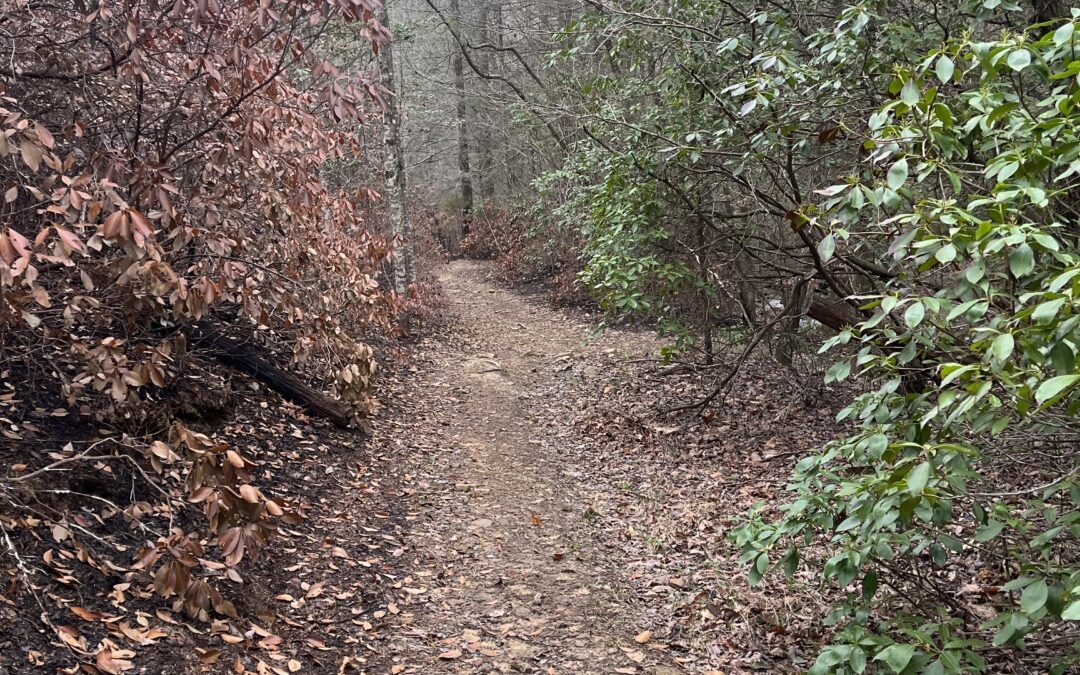Mountain Laurel pictured above. The trail acted as a fire break here keeping one side of the laurels unaffected.
Several weeks ago a wildfire was sparked at the base of Woodcock. Dunlap Fire Department says the fire was likely started by someone burning leaves at the base of the mountain on Woodcock Road. The fire burned through 500+ acres of land, including our Woodcock property. Thankfully, it appears that none of our valued climbing resources were damaged. While the fire was of relatively low severity it was a stark reminder that fires have a complex relation with our Southeastern ecosystem.
It’s easy to assume that fire should always be avoided, but the reality is more nuanced. Throughout history fire was a natural and necessary part of our Southeastern ecosystems. Within the last 10 years, fire suppression has altered the dynamic between people, land, and fire, contributing to the loss of fire-resilient ecosystems. Read on for an exploration of the adverse and beneficial effects of fires in our cherished forests.
Adversity: The Drawbacks of Fire
There is no denying the presence of harmful effects originating from the embrace of fire’s flames. Fire can rip families from their homes, roll through large urban areas reeking havoc, and displace hordes of wildlife. The Eaton fires in California are a prime example of the level of destruction fire can claim. There are a couple of other less obvious ways that fire’s damages persist.
- Damage to soils: The heat of fire can strip the soil of the beneficial microbes and lead to the loss of nutrients. The higher the intensity the further the heat can penetrate into the soil substrate, destroying the roots and fibers holding the soil together. This process leaves the soil vulnerable to erosion.
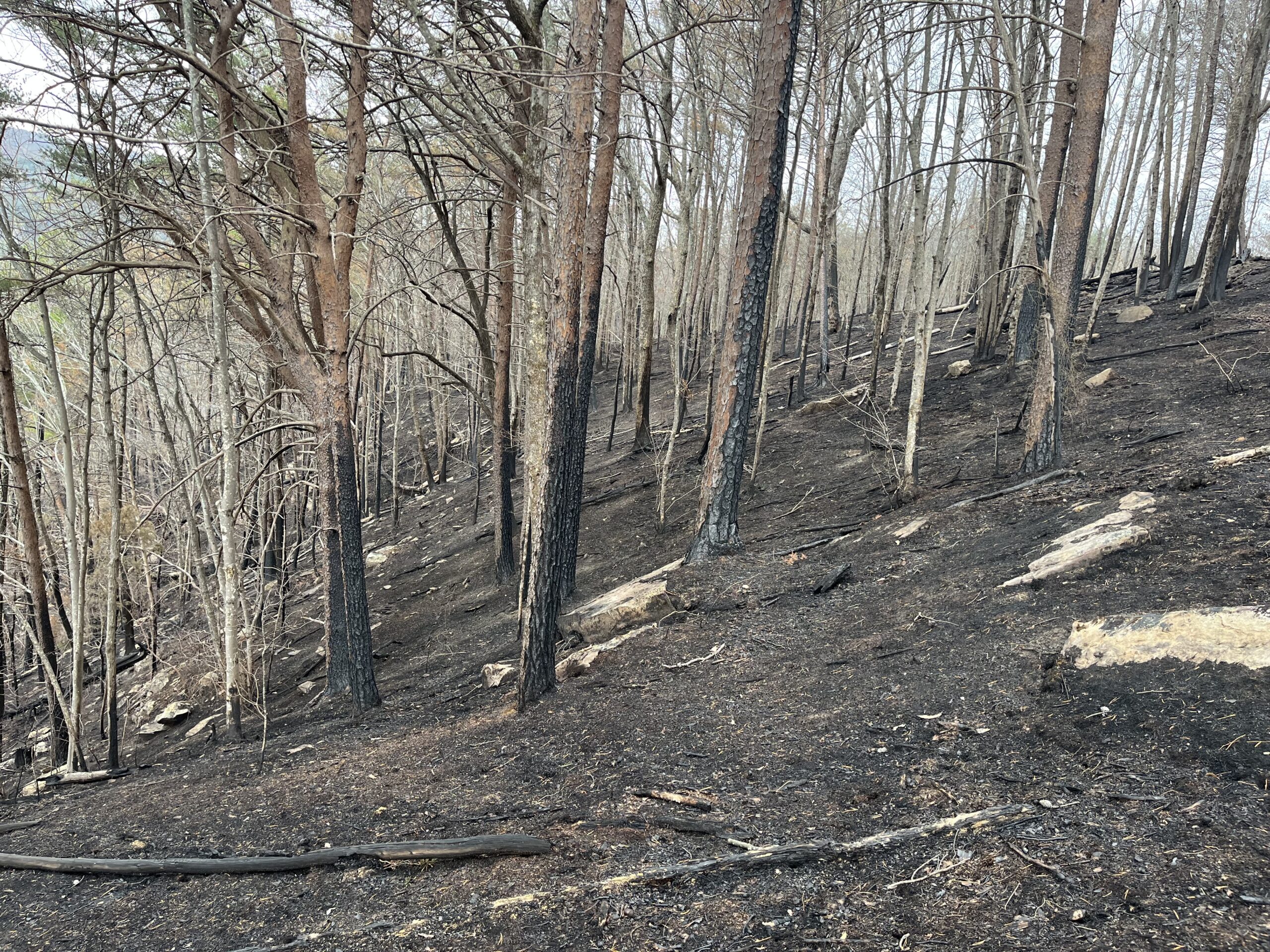
Steep slopes above the cliff. This area will be monitored for future erosion potentials due to the loss of underbrush.
- Wildlife disruption: Wildlife attempts to flee as a fire roars through their homes. Many can perish in the flames while others are forced to relocate. Some of these critters can happily make a new home where they land, however many are threatened as their food sources are demolished.
- Air quality concerns: Fire can produce quite a lot of smoke. The more vulnerable populations face the highest risks from the increased smoke in the air, especially those with respiratory issues.
Many of these factors contribute to the belief that fires are inherently bad. While our property ultimately did not have catastrophic damage, our neighbors, The Chattanooga Society of Model Engineers, left with a significant amount of property damage. These are the serious consequences we can experience when a wildfire burns out of control. If this was a controlled and managed burn there would have been fire breaks in place to keep the fire from damaging valued infrastructure. It is critical to understand that while we should have caution with fires, they are also important in maintaining the ecosystems homeostasis.
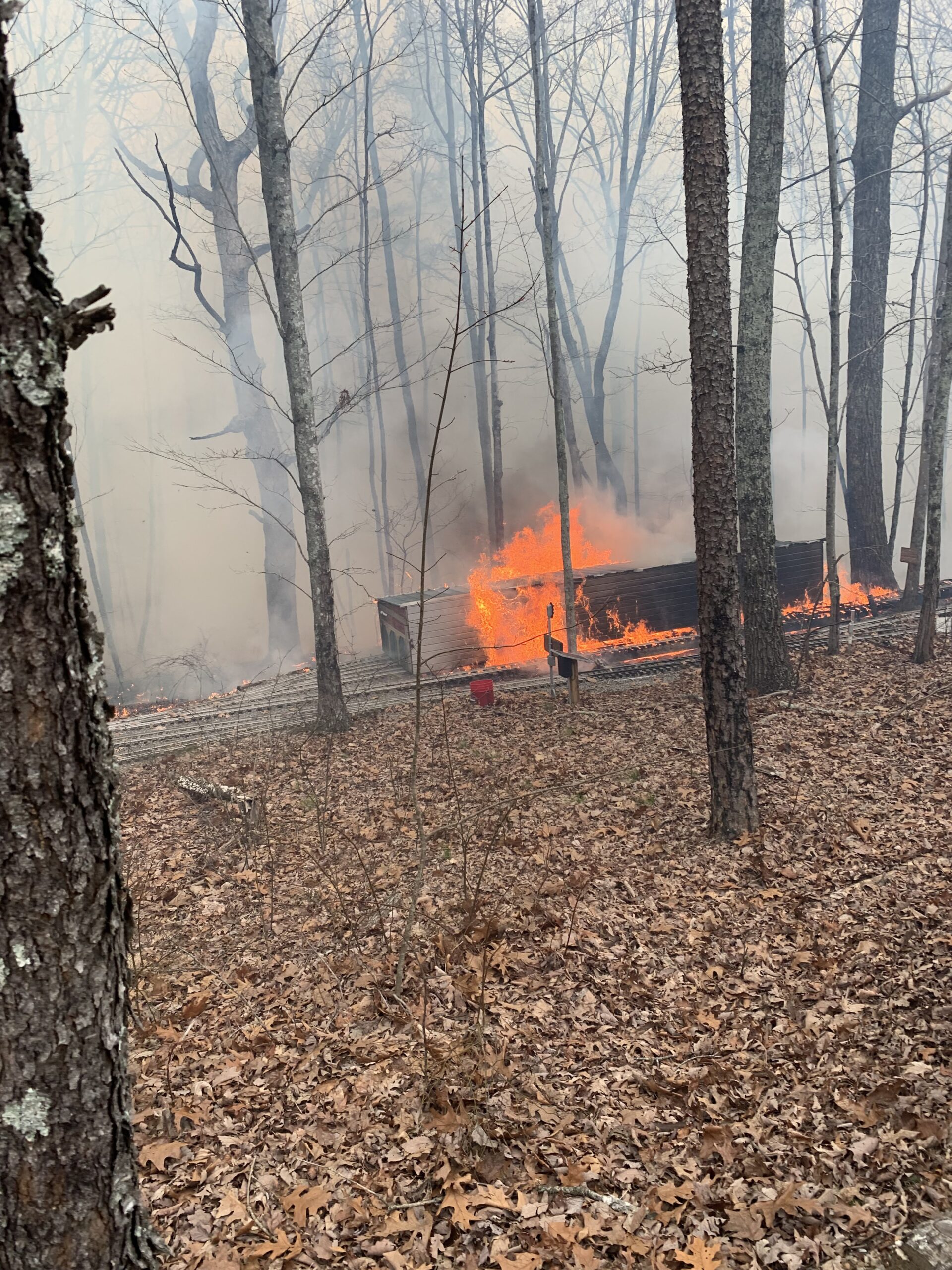
Eagle Point Railroad fire. Model depot seen above engulfed in flames. Photo courtesy of https://www.csme-eprr.com/
Benefits: A Natural Cycle
Prior to the advent of fire suppression, fire was a regular component of the natural regeneration cycle of Earth’s ecosystems. Indigenous cultures have historically used fire as a tool to promote biodiversity and decrease the risks of catastrophic fires.
- Forest floor renewal & Biodiversity: Low-severity fires, similar to the one we just witnessed, can help clear out dead plant matter. This opens up the forest floor for new plants to occupy the space. This cleaning house disrupts the equilibrium of the area giving other species a chance to thrive. The break in the cycle contributes to a rise of species diversity in the region. There are also some species that are dependent on fires to survive. Check out this fungus that was spotted after the fire, found exclusively in heat-burned areas. We would never see this fungus without fires!
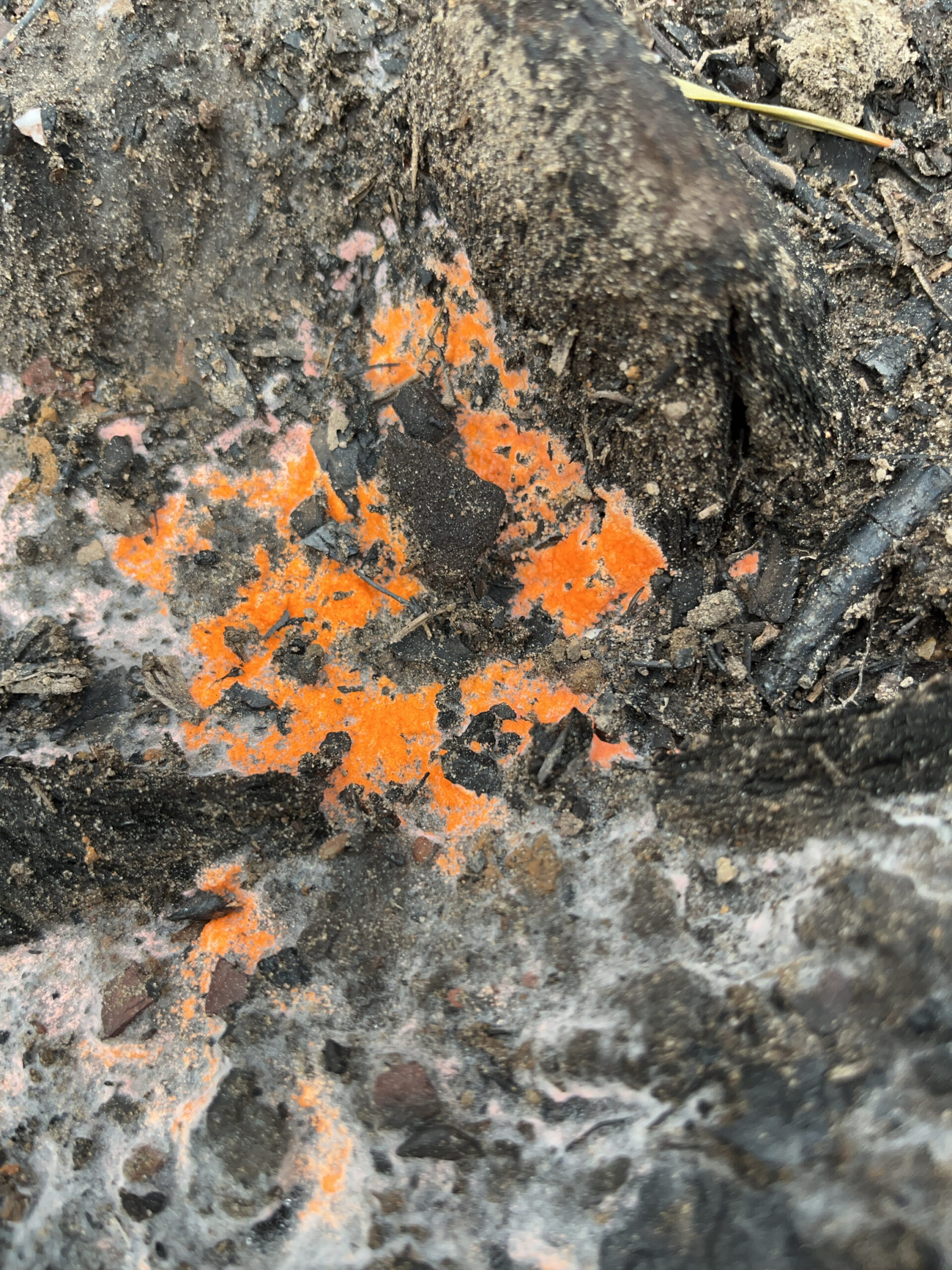
Fruiting fungus of the genus pyronema. This fungus fruits when exposed to extremely high heat. It can be classified as an extremophile type species.
- Wildlife habitat: There are many species that rely upon open environments for survival. Fires can be beneficial for maintaining prairies that grazing species utilize. Fires clear out the understory and generate some of these wide open spaces that otherwise would be covered in brush. These open woodland spaces are called glades. Glades are historically present in forests and have an open nature that is critical for grasses, forbes, and wildflowers survival.
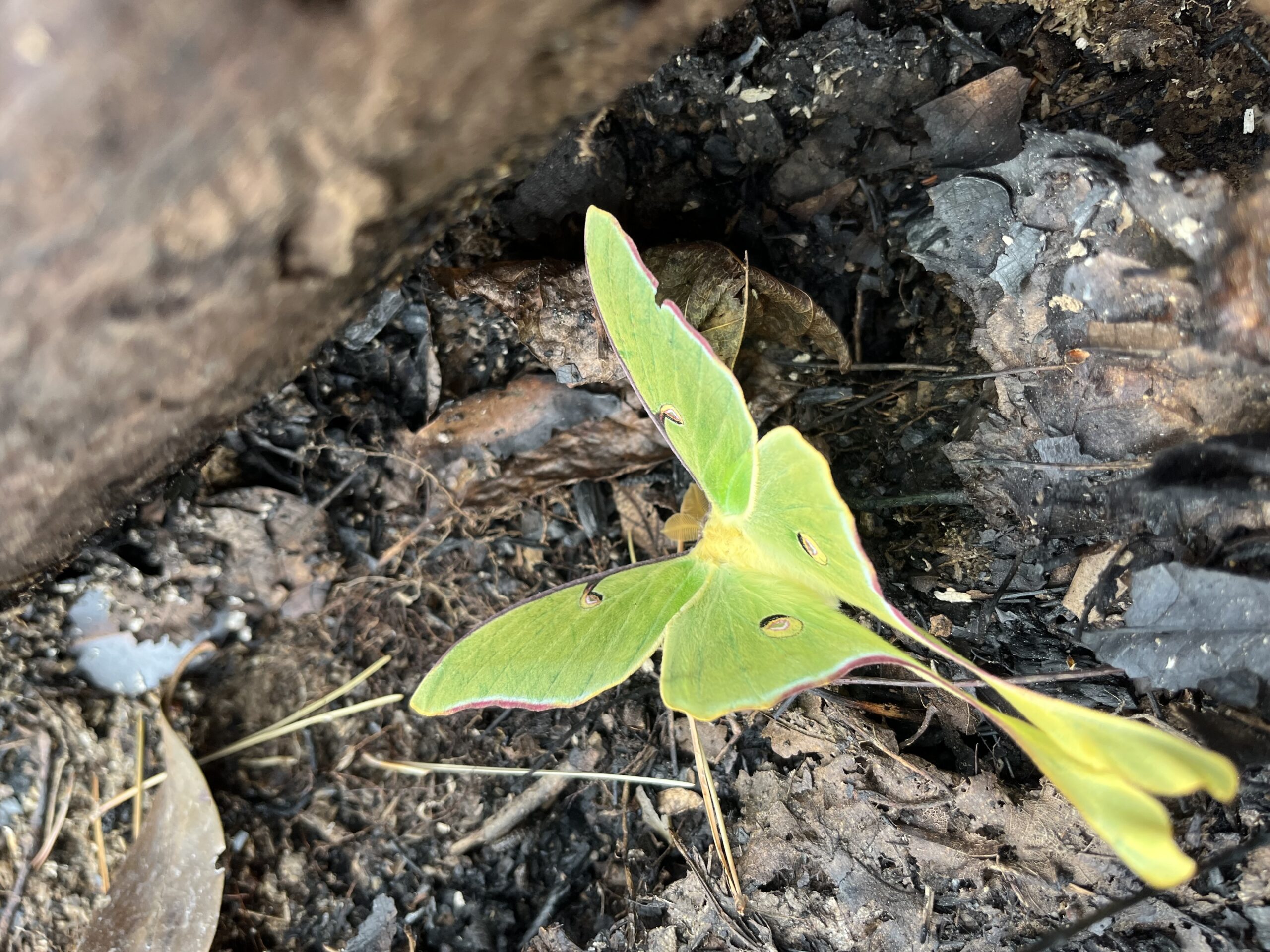
Luna moth (Actias luna) seen on the property post fire.
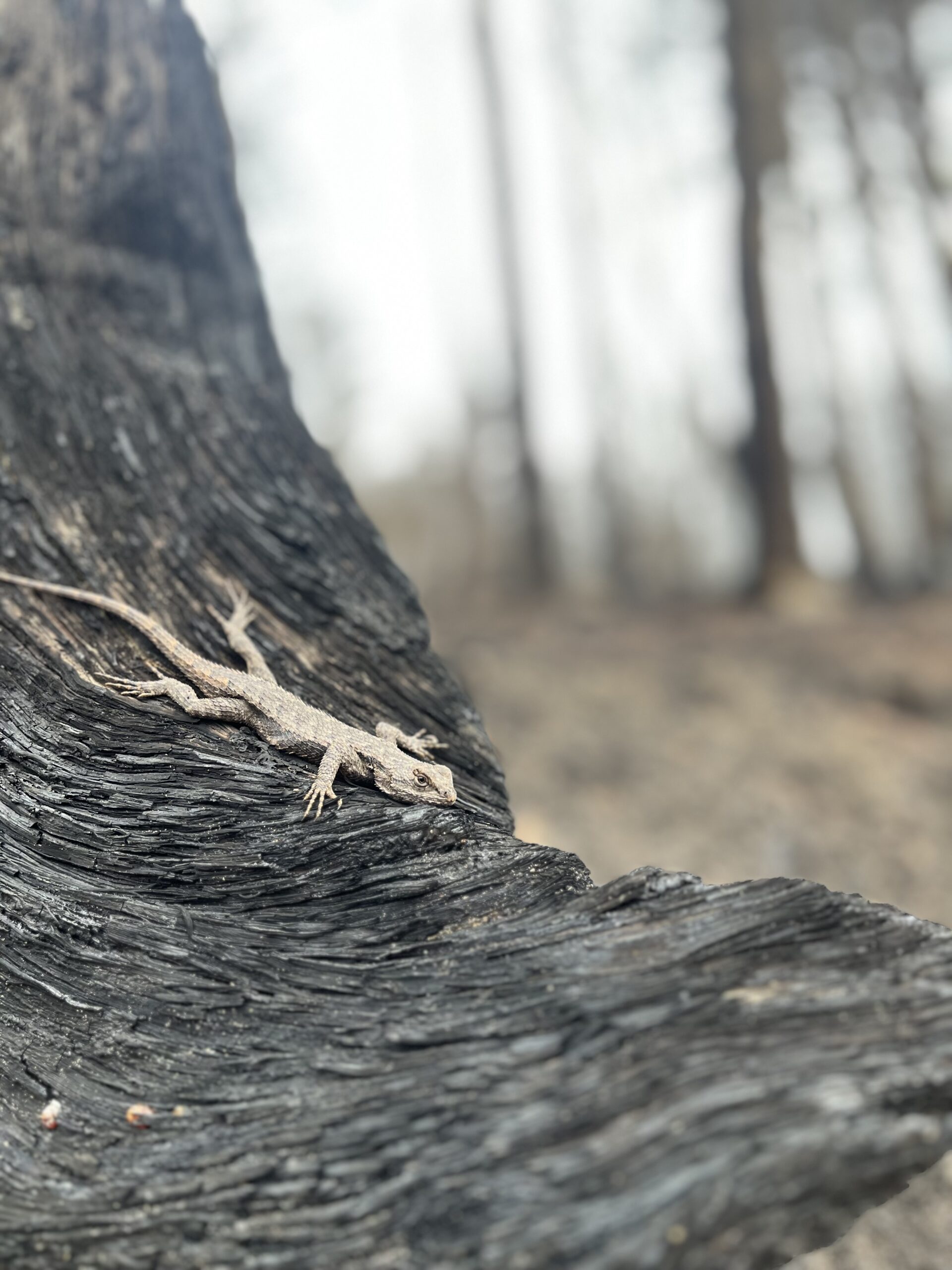
Eastern Fence Lizard (Sceloporus undulatus) spotted resting on a burned out stump.
- Reduction of fuel loads: Smaller, less intense fires like the one at Woodcock clear out accumulated brush and dead plant matter. Without these safer burns, major wildfires can accumulate such a strong force that they are a danger to society and can wreak havoc upon a forest. Smaller, prescribed burns reduce the fuel load and prevent major events.
Fire Suppression and the Loss of Resilience
Fires raging through a forest, razing cities to the ground, smoldering tree stumps left in the wave of destruction. This imagery has been the cornerstone of the insistence on fire suppression. While that land management tactic has undoubtedly worked to protect homes and infrastructure, it has some unintended consequences. For millennia, fire was a part of the natural cycle of environs. However, the advent of fire suppression has altered the balance of the forest.
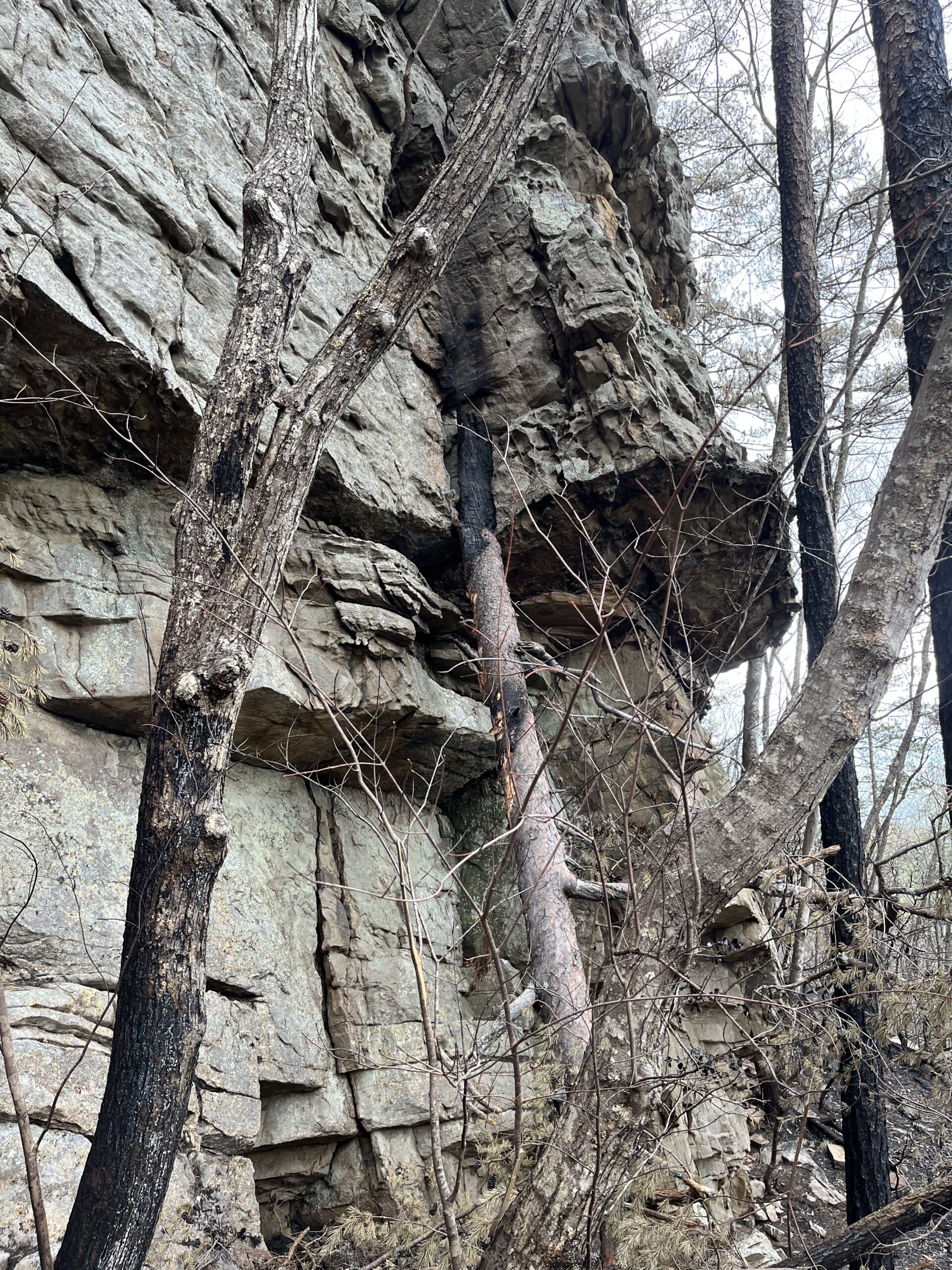
A hollow Virginia Pine acted as a chimney up this section of rock. This is not near any established climbs.
Fires have historically contributed to the resilience and diversity of ecosystems. Our southeastern landscapes, through fire suppression, have lost some of the fire resilience. This has created forests that are less capable of bouncing back and flourishing post fire events. The fire suppressions, while intended to avoid catastrophic fires, have contributed to the build up of fuel loads in the forests. These growing loads, going unchecked by smaller, more frequent fires, set the stage for massive fires to ignite.The larger fires are much more challenging to control and prevent from damaging infrastructure. While the intention of fire suppression was in protection of peoples and structures, the unintended repercussions were a reduction of fire resilient ecosystems and more serious fire potentials from higher fuel loads.
Finding the Balance
Embracing the dualism of fire requires a thoughtful approach. While our urban areas might require fire suppression as the locus for protection, the same is not true for all natural spaces. Utilizing fire as a management tool rather than eschewing it as an entirely destructive force would be beneficial for people and ecosystems. While fire is not entirely risk-free it can be managed responsibly.
Prescribed burns, when employed correctly, can restore landscapes and strengthen existing ecosystems. Controlling fires can be a protective force for our infrastructure, keeping the fuel loads from accumulating to unmanageable levels. Using fire in a land management plan, by trained professionals, can promote the fire resilience of an area, benefit native flora and fauna, as well as restore the natural processes that have shaped our region.
As climbers and stewards of the land, it’s crucial we support responsible fire management and embrace the positive role fire can play in keeping our forests, wildlife, and climbing areas healthy for future generations.
So, let’s stay aware, stay safe, and embrace the duality of land’s natural rhythms—fire included.
References:
- Bowman, D. M. J. S., et al. (2011). “The impact of fire on biodiversity.” Ecology and Evolution, 1(4), 1-17.
- Certini, G. (2005). “Effects of fire on properties of forest soils: A review.” Oecologia, 143, 1-10.
- Hunter, M. L. (2001). The necessity of fire for biodiversity conservation. Springer Science & Business Media.
- Pyne, S. J. (2017). Fire in America: A Cultural History of Wildland and Rural Fire. Princeton University Press.
- Smith, P., et al. (2013). “Wildlife habitat and fire regimes.” Wildlife Biology, 19(1), 12-22.
- Varner, J. M., et al. (2016). “Fire-adapted ecosystems of the southeastern United States.” Fire Ecology, 12(1), 98-114.
- Whelan, R. J. (1995). The Ecology of Fire. Cambridge University Press.
- Western Regional Air Partnership. (2018). Air Quality and Wildfires. www.wrapair.org
- Hutto, R. L. (2008). “The effects of fire on wildlife in the Western U.S.” Journal of Wildlife Management, 72(4), 1237-1244.
- National Park Service. (2024). Indigenous fire practices shape our land. U.S. Department of the Interior. https://www.nps.gov/subjects/fire/indigenous-fire-practices-shape-our-land.htm
- National Park Service. (2025). Buffalo National River conducts 2019 wilderness prescribed fire. U.S. Department of the Interior. https://www.nps.gov/articles/000/buffalo-national-river-conducts-2019-wilderness-prescribed-fire.htm
- Boerigter, C.E., Parks, S.A., Long, J.W. et al.(2024). Untrammeling the wilderness: restoring natural conditions through the return of human-ignited fire. Fire Ecology, 20(76). https://doi.org/10.1186/s42408-024-00297-5
- Clark, S.A., Archer, J.N., Stephens, S.L. et al.(2024). Realignment of federal environmental policies to recognize fire’s role. Fire Ecology, 20(74). https://doi.org/10.1186/s42408-024-00301-y
